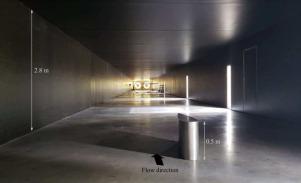当前位置:
X-MOL 学术
›
Int. J. Heat Fluid Flow
›
论文详情
Our official English website, www.x-mol.net, welcomes your
feedback! (Note: you will need to create a separate account there.)
Downstream evolution of junction flow three-component velocity fluctuations through the lens of the diagnostic plot
International Journal of Heat and Fluid Flow ( IF 2.6 ) Pub Date : 2020-10-01 , DOI: 10.1016/j.ijheatfluidflow.2020.108665 S.J. Zimmerman , S.K. Romero , J. Philip , J.C. Klewicki
International Journal of Heat and Fluid Flow ( IF 2.6 ) Pub Date : 2020-10-01 , DOI: 10.1016/j.ijheatfluidflow.2020.108665 S.J. Zimmerman , S.K. Romero , J. Philip , J.C. Klewicki

|
Abstract Experimental measurements of the streamwise and transverse velocity components have been acquired in three spanwise/wall-normal planes in the wakes of both a streamlined ‘wing’ and a bluff ‘wing’ junction. The ‘extended’ diagnostic plot introduced by Alfredsson et al. (2011) (see figure 3 therein) is used as a benchmark to locally evaluate the departure of turbulent wing-body junction flow wakes from ‘equilibrium’ boundary layers. Both obstacles produce a secondary flow of Prandtl’s first kind, which disrupts the equilibrium implied by the universality of the extended diagnostic plot. The plane wake of the obstacle itself (away from the junction) also disrupts this equilibrium. It is found that with downstream development the boundary layer eventually recovers to the base zero-pressure-gradient ‘equilibrium’, and that this recovery process emanates from the near-wall region. The transverse velocity components are also examined in “extended diagnostic” form, revealing that the wall-normal fluctuations recover to the zero-pressure-gradient case near the wall more rapidly than the wall-parallel components.
中文翻译:

通过诊断图的镜头,结流三分量速度波动的下游演变
摘要 在流线型“翼”和钝“翼”交汇处的尾流中,在三个展向/壁法向平面中获得了流向和横向速度分量的实验测量。阿尔弗雷德森等人引入的“扩展”诊断图。(2011)(参见其中的图 3)被用作基准来局部评估湍流翼体连接流尾流从“平衡”边界层的离开。这两个障碍都产生了普朗特第一类的二次流动,它破坏了扩展诊断图的普遍性所暗示的平衡。障碍物本身的平面尾流(远离交界处)也破坏了这种平衡。发现随着下游的发展,边界层最终恢复到基础零压力梯度“平衡”,并且这个恢复过程来自近壁区域。横向速度分量也以“扩展诊断”形式进行检查,表明壁法向波动比壁平行分量更快地恢复到壁附近的零压力梯度情况。
更新日期:2020-10-01
中文翻译:

通过诊断图的镜头,结流三分量速度波动的下游演变
摘要 在流线型“翼”和钝“翼”交汇处的尾流中,在三个展向/壁法向平面中获得了流向和横向速度分量的实验测量。阿尔弗雷德森等人引入的“扩展”诊断图。(2011)(参见其中的图 3)被用作基准来局部评估湍流翼体连接流尾流从“平衡”边界层的离开。这两个障碍都产生了普朗特第一类的二次流动,它破坏了扩展诊断图的普遍性所暗示的平衡。障碍物本身的平面尾流(远离交界处)也破坏了这种平衡。发现随着下游的发展,边界层最终恢复到基础零压力梯度“平衡”,并且这个恢复过程来自近壁区域。横向速度分量也以“扩展诊断”形式进行检查,表明壁法向波动比壁平行分量更快地恢复到壁附近的零压力梯度情况。











































 京公网安备 11010802027423号
京公网安备 11010802027423号